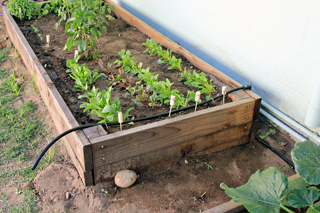 This last few weeks have really focused my mind on the importance of water, and made me think harder about how I garden and plant.
This last few weeks have really focused my mind on the importance of water, and made me think harder about how I garden and plant.
In practice, we had 5-6 weeks with almost no rainfall, and just a few dewy nights keeping things a little fresher. And this is Cornwall, supposedly one of the wettest parts of England, if not the UK. Coupled with some steaming temperatures in the last few weeks, the water butts were empty and even the old tank where we gather water from the roof was so low I could barely reach the surface with a can without falling in (is that hubby’s plan, I ask myself? ….hmmmmmm……)
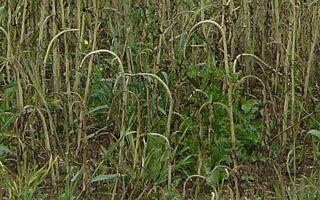 Anyway, I confess that I resorted to the hosepipe on occasion on my precious veg beds and cut flower patches – no way was I going to lose those after all the work I’d put in. What would have been more efficient though, in retrospect, was a slow drip irrigation system. Not necessarily the prettiest of garden paraphernalia, but certainly very effective, and reasonably cheap and easy to install.
Anyway, I confess that I resorted to the hosepipe on occasion on my precious veg beds and cut flower patches – no way was I going to lose those after all the work I’d put in. What would have been more efficient though, in retrospect, was a slow drip irrigation system. Not necessarily the prettiest of garden paraphernalia, but certainly very effective, and reasonably cheap and easy to install.
With a simple timer, you can control the way to slowly irrigate your chosen area at the most efficient time for the plants to take up the water (first thing in the morning, ideally) and deliver it directly to the plants roots. Even though I am a hosepipe user when up against it, even I recognise that a good proportion of hose water does not hit its intended target, and what’s more, evaporates before being effective for the plant. I have such a system in my greenhouse for my tomatoes and cucumbers etc, and it is very helpful. It’s on while I sit and write this for example, and I know it’ll get the water right where it needs to go.
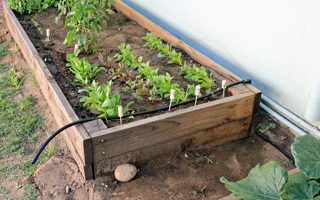 As for the rest of the garden, there is no way I could water it all. If you find yourself in that position too, there is a triage list I operate by.
As for the rest of the garden, there is no way I could water it all. If you find yourself in that position too, there is a triage list I operate by.
1.Prized specimens. If all else fails, give your really prized plants a soak at the expense of others This especially applies to shrubs and trees planted with the last 12 months, and herbaceous planted this year, that have most likely not been able to develop an extensive root system yet. And however tempting, delay planting any shrubs or larger herbaceous at the moment. You will not be doing yourself or the plants any favours, because you’ll increase the chance of failure, and that’s just plain discouraging and expensive.
- Cut down the number of planted containers you have. There is this misconception that pots are easier to look after than plants in the ground. Sorry to disappoint, but they’re not. They dry out more quickly because the ceramic heats up and slow-cooks the compost (terracotta = baked earth) need more feed, need repotting regularly and their growth is generally restricted by the container. Unless you really have no other choice, in the ground is best.
- An overnight dunk can sometimes help. If you have a pot that has dried out enormously, it might benefit from standing in a few inches of water overnight to rehydrate the compost. Remember to take them out and let them drain though, as these are not pond plants.
-
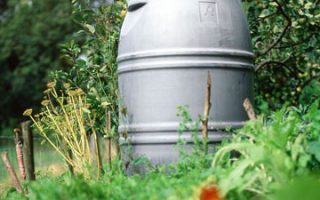
BJBK8M A plastic water container in a rural Welsh organic garden, Carmarthenshire, Wales UK. Image shot 2009. Exact date unknown. Increase your water gathering capacity. More butts, frankly. OK, not a short term response, but consider all the water we use/waste in the house that could be used at dry times. If you were to use an eco-friendly washing up liquid, you could put the used water at the base of your plants without harming them. Similarly, do you run the hot tap until it warms up? (Guilty) The water that goes down the sink could go into a bucket and be used. Dehumidifier water can be saved. The list goes on.
- And ultimately, we can change how we plant. I have certainly been thinking harder about this, blessed as I am with a garden full of shrubs and herbaceous perennials, the latter of which wilt readily. In one problem area (an old bank come rockery disguising a mountain of building rubble), I completely revamped this last spring and put material that needs little soil, poor soil at that, and are drought tolerant. Grasses of all sorts, achillea, rudbeckia, agapanthus, dianthus, callistemon, several types of lavender, santolina, rosemary, a funky hebe (not a fan of the traditional pudding-shaped ones), teucrium, succulents such as echeveria and sempervivum..…and so on. And nothing has needed watering, even through this driest of spells. Food for thought indeed. This last picture is RHS Hyde Hall, Essex, the driest county in England
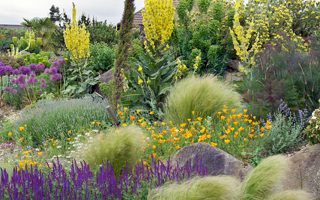 A good 24 hours hours of rain a week or so ago has replenished the butts and tanks for now, but I think we all need be a bit smarter in our gardens if we are likely to be on the receiving end of these hot spells more frequently.
A good 24 hours hours of rain a week or so ago has replenished the butts and tanks for now, but I think we all need be a bit smarter in our gardens if we are likely to be on the receiving end of these hot spells more frequently.
Right, on to the next problem. Earwig traps for my dahlias – they are currently nibbling every bloom that opens and if I am to stand even the smallest chance of regaining my dahlia cup from my friend next door at the Veryan Show in September, that has to stop!! Luckily, our local farmer has just harvested so off to collect some straw, some canes, flower pots, wet the straw and combine. Hopefully the wiggys will move in and be moved on.
Enjoy your summer everyone!!
Helen Robins

